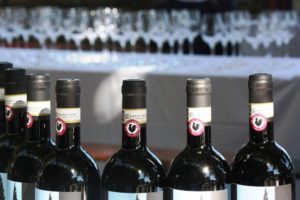Articolo disponibile anche in: Italian
We can confidently claim 2019 as a classic vintage year for the Gallo Nero area.
Winter and early spring were relatively mild and dry, enabling normal budbreak to occur.
The rain in late spring created significant supplies of water, adequate to face a hot summer with even temperatures and little rainfall.
The cool, damp weather in May and early June caused a slight delay in the vines’ vegetation cycle compared to previous years, at a pace similar to the great 1980s vintages.
The even, high summer temperatures without peaks or heavy rain, were followed by good weather in September with considerable night-day temperature variation, resulting in grapes with perfectly ripe phenolics, and a general increase in aroma quality.
The Sangiovese harvest began, depending on the different production zones, around 20th September and ended in the middle of October, bringing high quality, healthy grapes to the cellars.
It may still be too soon for a definitive assessment but the wines destined to become our 2019 Chianti Classicos are expected to be fresh and well-balanced, thanks to the good balance between acidity and tannin, perfectly concentrated texture and excellent aromas. The alcohol content is slightly lower than average compared to previous vintages, in line with the market trends.
To summarise, we are looking at an excellent vintage year that will perfectly enhance the characteristic features of the Sangiovese grape and the many facets of such a widely varied area in terms of soil diversity and microclimates, as Gallo Nero. The future Chianti Classico 2019 wines how highly unique and concentrated extract, anthocyans, polyphenols and varietal aromas.
The results have also been very positive this year in terms of quantity: almost everywhere the quantities of grapes were in line with the requirements of the production specifications, and while yields are not yet definitive, they seem to be within normal parameters (total production: about 300,000 hl).
2018
Total production: 275,000 hl
In the Chianti Classico production territory 2018 showed an uneven and changeable weather pattern throughout the vineyards’ vegetative cycle.
Unlike the previous year, which experienced very high temperatures and a long period of drought through spring and summer, the main feature of 2018 was a lack of sustained dry, sunny weather.
The rather cold winter, with snow and some very low – occasionally subzero – temperatures especially in late winter, was followed by a very changeable spring.
Throughout the season and for much of the summer, sunny days alternated with more or less short spells of often very heavy rain. This high and consistent humidity level combined with periods of daily rain created a lot of extra work in managing the health of the vineyards.
The weather failed to settle even during the summer, with storms until the beginning of September which raised humidity and kept the temperatures at a below-average cool level for the season, resulting in an extended maturation period for the grapes.
The agronomists struggled to maintain the balance of development on the vines which continued to produce vegetation until late August.
Fortunately the situation settled into a regular pattern in September, when the weather completely changed: hot, sunny days with a good night-day temperature variation enabled the grapes to ripen fully and the harvest to go ahead without further problems.
With some variation according to the different growing areas, the Sangiovese harvest began around 20th September and ended in mid-late October.
The quantities harvested were higher than in 2017, but still a little below the average compared to recent years. The reasons for this can be traced back above all to the stress experienced by many vineyards due to the previous year’s drought and spring frosts.
In terms of quality, it was certainly a very good year for those who managed to harvest quite late, and the wines that have completed malolactic fermentation are, almost everywhere, very interesting. Most of them show good balance, with good levels of acidity and sweet, mature tannins, excellent body and flavour.
The wines destined to become Chianti Classico 2018 generally show a good level of concentration and fresh, aromatic and very pleasant aromas that will certainly please many markets. Much of the 2018 production has ideal chemical and organoleptic features for medium-long ageing.
2017
Total production: 206,000hl
Weather trend: 2017 was a tough challenge for our winegrowers, as one of the driest years in recent decades. The early months were variable with rain only in late February and March. From May onwards there was very little rain.
This was accompanied by temperatures constantly above the seasonal average with extremely high peaks, especially in July and August.
The unusual late frosts in spring caused a reduction in potential quantities, but this proved favourable in later stages of fruit development, because thanks to the lower quantities, the vines suffered less stress due to the lack of rain and high temperatures, which guaranteed full ripening of the grapes. The rain in the first few days of September, light but adequate for the final pre-harvest period, also facilitated the conclusion of the production cycle.
To cope with these highly unusual weather conditions, meticulous care over vineyard management was more vital than ever before. Thanks to the consistent and thorough attention of our winegrowers to all the processes, we managed to bring healthy grapes of excellent quality into the cellar.
Like the rest of Italy, fewer grapes were produced in the Gallo Nero area. In 2017 206,000hl of Chianti Classico was produced (about 27% less than the previous year), the lowest quantity in the last 40 years.
Despite the significantly lower production quantities, the quality of the 2017 wines was, from the first tasting, a pleasant surprise. The colour alone is extremely promising, because the intensity and hues are generally very interesting, lively and deep. The aromas were also particularly pleasing, currently very vibrant and varied with foreground fruity notes.
The tannins are generally very developed and smooth. So overall this is a very pleasant vintage, despite initial doubts, that has produced fine quality wines that promise well for future development.
2016
Total production: 281,000hl
Weather trend: 2016 was a generally normal year, without health issues for the vineyards. The only event to attract the growers’ attention was the lack of rain in late July during veraison, but the drought was relieved by rain in late August and early September. Steady warm weather without peaks of excessive heat in the final month maintained the balance and helped the grapes to ripen perfectly without over-maturation.
The summer was excellent overall, with little rain and high temperatures in July and August, but above all, marked temperature variation at night, which should translate into wines with high quality aromas and acidity.
This vintage, more than many others, will particularly enhance the characteristic features of the Sangiovese grape: rich extract, anthocyans, polyphenols and unique, highly focused varietal aromas.
2015
Total production: 300,000 hl
Weather trend: for the Chianti Classico territory, 2015 can be considered an excellent year thanks to the flawless quality of the grapes due to regular weather conditions. The winter was mitigated by alternating below zero temperatures and cold days. The spring was very mild with medium-high temperatures favouring regular vegetation budding. The summer was excellent overall, with little rain and high temperatures in the months of July and August, countered by good night-time variation.
All the phenological stages (budding, flowering, fruit setting and veraison) were perfect. The year can therefore be considered of a very high standard of quality, enhancing more than many others the characteristic features of Sangiovese: extract levels, anthocyans, polyphenols and unique, focused varietal aromas.
2014
Total production: 293,000 hl
Weather trend: 2014 showed marked temperature variations and plenty of rain, with short but heavy showers alternating with windy days and below average temperatures which sorely tested the winegrowers. Those who decided to thin out in various phases and paid more attention to their own vineyards, ensuring foliage development, managed to obtain excellent products.
The work carried forward by technical experts and growers in the months prior to the harvest guaranteed successful achievement of a high standard of quality for the 2014 wines, from quite an unusual vintage year. Many estates had to invest in extra workers and extended timetables to keep the problems caused by excessive rain under control, carrying out thinning and drying and disinfecting the areas at highest risk (low altitude vineyards).
At the end of the summer winegrowers in central-northern Italy were set to deal with one of the most problematic harvests in history. No exceptions were made for Chianti Classico, where the weather conditions led to parasite attacks in some areas.
The first samples of grapes from the territory, picked in late August, had not fully completed veraison and showed a high level of acidity.
However, the favourable weather conditions in September and early October, with warm days and cool nights, allowed the plants to ripen gradually but fully. This made it possible to harvest grapes in mid-October (especially Sangiovese) able to produce stylish, well-balanced wines with marked aromas and acidity, perfect for subsequent maturation.
2014 wines are unconventional, with very intense colour thanks to the extractable anthocyans, but which show the marked stamp of Sangiovese grapes, which contribute body and harmony due to the high percentage of polyphenols. Despite the problems in the various pre-harvest stages, Chianti Classico 2014 was also produced in above average quantities compared to previous years.
2013
Total production: 258,000 hl
Weather trend: from a strictly meteorological point of view, the first half of 2013 experienced high levels of rainfall with temperatures that tended to settle below the seasonal average: a proper winter, with close to 0° temperatures in Chianti, was followed by a delay in reversing the wintry trend in springtime, resulting in late flowering.
The heat really arrived in mid-July, accelerating the grape ripening process, which continued steadily throughout a summer with typical temperatures and a perfect September which highlighted the temperature variation recorded in summer and enabled the grapes to achieve a well-balanced ripeness.
The work of the experts and winegrowers carried out in the months prior to the harvest were decisive in successfully achieving of high quality standards. While the early samples of Sangiovese grapes, the true soul of Chianti, expressed a good level of sugar with good acidity, at the end of the day we can confirm that the quality of the grapes in the Gallo Nero production zone was above average, with excellent levels of polyphenolic ripeness and perfect harmony with the acidic structure of the grapes.
These parameters, along with the contained concentration of sugars in the must, made it possible to enhance all the grapes’ potential during the vinification process. The alcoholic fermentation first, and subsequent malolactic, showed sudden starts and regular progress without particular problems, which demonstrated the healthy condition of the grapes and excellent balance of their main components.
The Chianti Classico 2013 wines display good balance of aromas and flavours, with particularly well judged flavour: the polyphenols, extract, tannins and glycerine harmonise so that no element prevails over the others, also thanks to the moderate alcohol content, due to the weather trend during the season.
2012
Total production: 258,000 hl
Weather trend: from a strictly meteorological point of view, the first half of 2013 experienced high levels of rainfall with temperatures that tended to settle below the seasonal average: a proper winter, with close to 0° temperatures in Chianti, was followed by a delay in reversing the wintry trend in springtime, resulting in late flowering.
The heat really arrived in mid-July, accelerating the grape ripening process, which continued steadily throughout a summer with typical temperatures and a perfect September which highlighted the temperature variation recorded in summer and enabled the grapes to achieve a well-balanced ripeness.
The work of the experts and winegrowers carried out in the months prior to the harvest were decisive in successfully achieving of high quality standards. While the early samples of Sangiovese grapes, the true soul of Chianti, expressed a good level of sugar with good acidity, at the end of the day we can confirm that the quality of the grapes in the Gallo Nero production zone was above average, with excellent levels of polyphenolic ripeness and perfect harmony with the acidic structure of the grapes.
These parameters, along with the contained concentration of sugars in the must, made it possible to enhance all the grapes’ potential during the vinification process. The alcoholic fermentation first, and subsequent malolactic, showed sudden starts and regular progress without particular problems, which demonstrated the healthy condition of the grapes and excellent balance of their main components.
The Chianti Classico 2013 wines display good balance of aromas and flavours, with particularly well judged flavour: the polyphenols, extract, tannins and glycerine harmonise so that no element prevails over the others, also thanks to the moderate alcohol content, due to the weather trend during the season.


